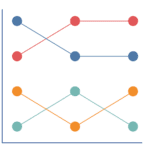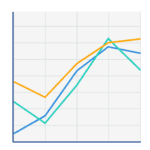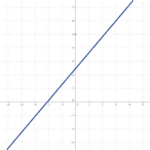Let’s take a moment to consider the importance of time. Time governs everything around us, doesn’t it? From the rise and fall of civilizations to the change of seasons, the growth of your favorite tree in your backyard, or the progress of your very own life – everything is in a constant dance with time. And understanding how things change over time is essential to understanding our world.
What if I told you that your life is surrounded by charts that show change over time and play a significant role in how you understand and interact with the world? The weather forecast you checked this morning, the news about stock market trends you read, the fitness progress you track on your smartphone, or the population growth stats you came across in a documentary are examples of change over time, visualized using charts.
But there’s a trick to understanding these charts, to truly get the message they’re designed to convey. Just as a writer uses words to weave a story, a chart uses shapes, colors, scales, and symbols. By the end of our time together today, you’ll be equipped to decipher this visual language and become a more informed, more aware participant in the dance of time.
 Area Chart
Area Chart
Think about your phone battery. When you wake up, it’s 100%, but as you use it throughout the day, the charge drops. This is precisely what an area chart can show us! An area chart is like watching the water level rise or fall in a glass – it shows how much of something you have at different points in time.
Essential facts about area charts:
- An area chart shows the quantity of one or more variables over time, represented as areas beneath a line.
- They make it easier to comprehend the magnitude of change and trends over time.
- Area charts are similar to line charts but emphasize the magnitude of values by filling the area below the line.
- Stacked area charts can show the contribution of different groups to a total over time, similar to stacked bar charts.
Just remember, when using an area chart, the area under the line is important, but don’t mistake it for volume – it doesn’t show how ‘full’ something is, but rather the total over time. Additionally, in stacked area charts, the area on top is affected by the one underneath, which can sometimes distort the perception of change. Also, the area can sometimes imply a sense of volume, which might be misleading.
 Bump Chart
Bump Chart
Imagine your favorite basketball players are in a race, and you want to see who’s in the lead after each game. That’s a job for the bump chart! The bump chart is like a race, showing who’s in the lead, who’s fallen behind, and who’s caught up over time. It’s like a leaderboard that changes every moment.
Important facts about bump charts:
- Bump charts are used to rank categories over time, representing each category with a line.
- They’re great for observing changes in rank over time.
- Unlike line or area charts, bump charts highlight the rank rather than the absolute or relative value.
- They are useful when the position of a category relative to others is important.
But it can get a little crowded if too many players join the race, so keep the participants to a minimum for a clear view! When bump charts become cluttered, they are hard to read, and they may hide the magnitude of changes because they focus on rank.
 Line Chart
Line Chart
Have you ever tried to find the trend in your test scores? Do they get better as you study more, or do they dip when you have other commitments? That’s where a line chart can help. A line chart is like a heart monitor; it beats up and down along with the rhythm of your data.
Important facts about line charts:
- A line chart displays the change in one or more variables over time by connecting data points with a line.
- They help highlight trends and patterns over time.
- Line charts are among the most straightforward and commonly used types of charts for showing time series data.
- Unlike bar or area charts, they focus on the trend rather than the individual values.
Just watch out not to guess what the next beat might be; it’s not a crystal ball! Be cautious about extrapolating trends beyond the data, as trends can change. Additionally, in complex line charts with multiple series, it can become difficult to distinguish between different lines.
 Slope Graph
Slope Graph
Now, consider comparing your height from the start and the end of the school year. You want to see how much you’ve grown, right? The slope graph shows just that. It’s like a mountain trail, connecting two points and showing the steepness of your journey.
Important facts about slope graphs:
- Slope graphs compare the change in a variable between two points in time.
- Each category is represented by a line that connects these two points.
- Slope graphs are simpler than line charts and are excellent for highlighting relative change between two-time points.
- They don’t show trends over multiple time points like line or area charts.
However, slope graphs can become cluttered when displaying numerous categories. Additionally, they fail to show the nature of changes between the two points in time, such as whether a change was gradual or abrupt. For instance, in a growth chart, it’s unclear whether you have a growth spurt in the middle or if it was a slow, steady climb. To understand these nuances, you’ll need another type of chart.
In your journey as a statistician, you’ll get to use all these chart types and more. They each have their strengths and weaknesses, just like superheroes! The key is knowing when to use each one, so you can tell the most exciting and accurate story with your data. But remember, with great data comes great responsibility!